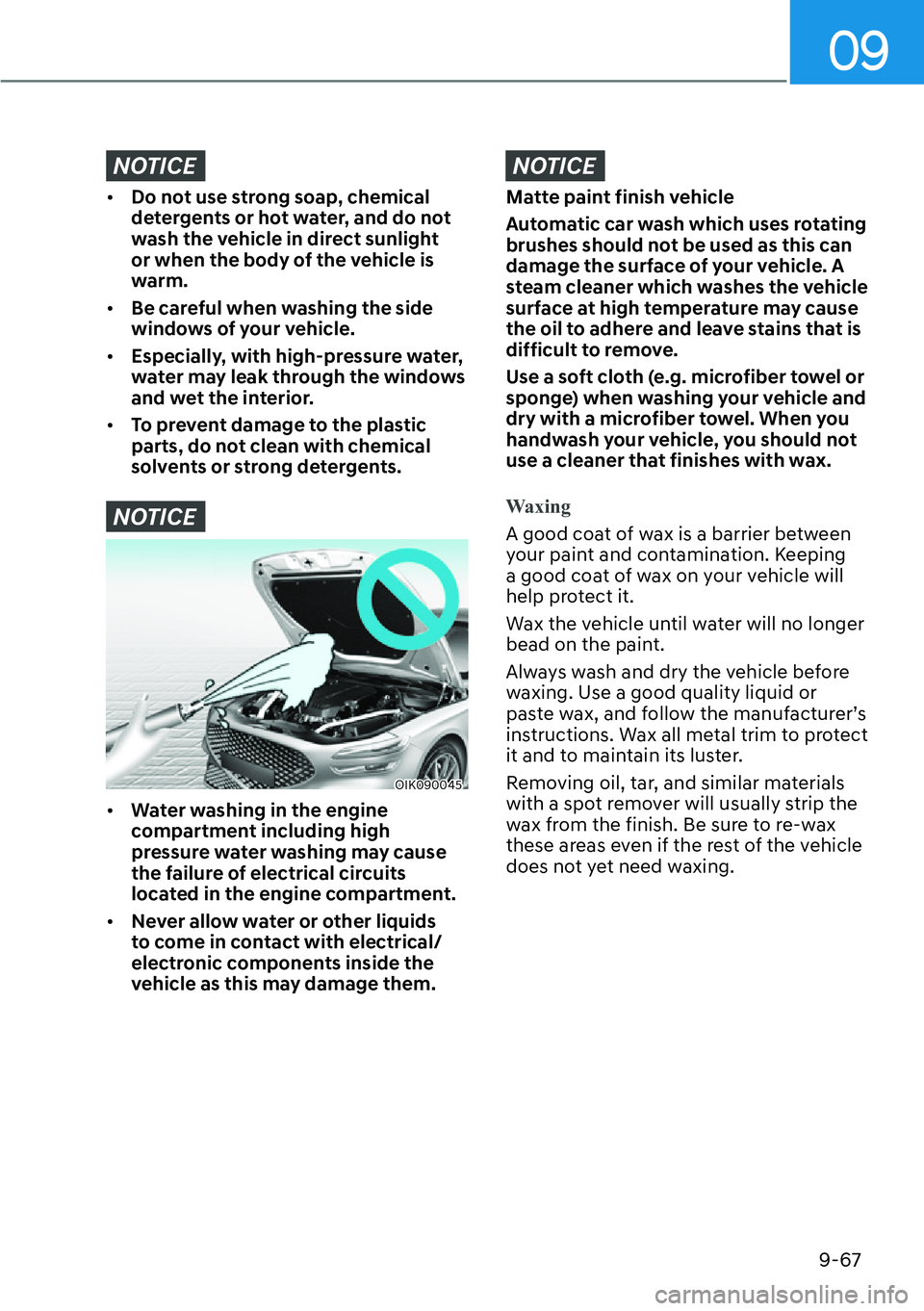Page 508 of 530

09
9-55
Engine compartment fuse panel
Fuse NameFuse Rating Circuit Protected
ESC310A ESP Control Module
ECU310A ECM
ECU215A ECM
HORN20A Horn Relay
WIPER130A Wiper Power Relay
TCU215A P/N Relay, TCM
SENSOR410AElectronic Oil Pump Module, Brake Vacuum Switch, E/R
Junction Block (RLY.1 (Brake Vacuum Relay))
TCU120A TCM
WIPER210A IBU, ECM
SENSOR115ARear Sub Junction Block (Fuel Pump Relay),
[D4HB] Rail Pressure Regulating Valve, DieseL Junction
Block (RLY.1 (Fuel Filter Heater Relay))
SENSOR520A[G4KL] Ignition Coil #1/#2/#3/#4
[G6DP] Ignition Coil #1/#2/#3/#4/#5/#6
[D4HB] Electronic Water Pump
MODULE10A Active Air Flap LH
ACTIVE HOOD10A Active Hood Lift Control Module
SENSOR110A[D4HB] Glow Relay Unit, Fuel Heater & Water Separator
Sensor
ECU120A ECM
SENSOR315A[G4KL] Oxygen Sensor (Up/Down)
[G6DP] Oxygen Sensor #1/#2/#3/#4
[D4HB] Lambda Sensor #1/#2, Electronic VGT Actuator,
Fuel Metering Unit, EGR Cooing Bypass Solenoid
Vlave, PTC Heater, Mid Nox Sensor, PM Sensor,
Rear Nox Sensor
Page 509 of 530
Maintenance
9-56
Fuse NameFuse Rating Circuit Protected
SENSOR210AE/R Junction Block (RLY. 9 - Cooling Fan Relay),
[G4KL] Electronic Thermostat, Oil Control Valve, Purge
Control Solenoid Valve, Recirculation Control
Solenoid Valve
[G6DP] Electronic Thermostat, Oil Pressure Solenoid
Valve, Oil Control Valve #1/#2/#3/#4 (Intake/
Exhaust), Recirculation Control Solenoid Valve,
Purge Control Solenoid Valve, Variable Exhaust
Flap Actuator LH/RH
[D4HB] Oil Pump Solenoid Valve, Air Flow Sensor,
Crankshaft Position Sensor, Front Nox Sensor, Oil
Level Sensor, Stop Lamp Switch
B/ALARM10A E/R Junction Block (RLY. 2 - Burglar Alarm Horn Relay)
Relay
Type Relay No.Relay Name
MICRO RLY. 1 Vacuum OIK090033
MICRO RLY. 2 Burglar Alarm Horn Relay
MICRO RLY. 6 Blower Relay
MICRO RLY. 7 Start Relay
MICRO RLY. 8 E-CVVT Relay (G4KL)
MINI RLY. 9 Cooling Fan Relay
Page 519 of 530

Maintenance
9-66
APPEARANCE CARE
Exterior Care
NOTICE
If you park your vehicle near a stainless
steel sign or glass facade building, the
vehicle’s exterior plastic parts such
as a bumper, spoiler, garnish, lamp or
side view mirrors might be damaged
due to sunlight reflected from the
sign or building. To prevent damage of
the exterior plastic parts, you should
avoid parking in areas where light may
be reflected or use a car cover. (The
exterior plastic parts applied to your
vehicle may vary.)
Exterior general caution
It is very important to follow the label
directions when using any chemical
cleaner or polish. Read all warning and
caution statements that appear on the
label.
Finish maintenance
Wa s h i n g
To help protect your vehicle’s finish from
rust and deterioration, wash it thoroughly
and frequently at least once a month
with lukewarm or cold water.
If you use your vehicle for off-road
driving, you should wash it after each
off-road trip. Pay special attention to the
removal of any accumulation of salt, dirt,
mud, and other foreign materials. Make
sure the drain holes in the lower edges
of the doors and rocker panels are kept
clear and clean.
Insects, tar, tree sap, bird droppings,
industrial pollution and similar deposits
can damage your vehicle’s finish if not
removed immediately.
Even prompt washing with plain water
may not completely remove all these
deposits. A mild soap, safe for use on
painted surfaces, should be used.
After washing, rinse the vehicle
thoroughly with lukewarm or cold water.
Do not allow soap to dry on the finish.
High-pressure washing
�[��When using high-pressure washers,
make sure to maintain sufficient
distance from the vehicle.
Insufficient clearance or excessive
pressure can lead to component
damage or water penetration.
�[��Do not spray the camera, sensors or
its surrounding area directly with a
high pressure washer. Shock applied
from high pressure water may cause
the device to not operate normally.
�[��Do not bring the nozzle tip close to
boots (rubber or plastic covers) or
connectors as they may be damaged
if they come into contact with high
pressure water.
WARNING
After washing the vehicle, test the
brakes while driving slowly to see
if they have been affected by water
before getting on the road. If braking
performance is impaired, dry the
brakes by applying them lightly while
maintaining a slow forward speed.
Page 520 of 530

09
9-67
NOTICE
�[��Do not use strong soap, chemical
detergents or hot water, and do not
wash the vehicle in direct sunlight
or when the body of the vehicle is
warm.
�[��Be careful when washing the side
windows of your vehicle.
�[��Especially, with high-pressure water,
water may leak through the windows
and wet the interior.
�[��To prevent damage to the plastic
parts, do not clean with chemical
solvents or strong detergents.
NOTICE
OIK090045
�[��Water washing in the engine
compartment including high
pressure water washing may cause
the failure of electrical circuits
located in the engine compartment.
�[��Never allow water or other liquids
to come in contact with electrical/
electronic components inside the
vehicle as this may damage them.
NOTICE
Matte paint finish vehicle
Automatic car wash which uses rotating
brushes should not be used as this can
damage the surface of your vehicle. A
steam cleaner which washes the vehicle
surface at high temperature may cause
the oil to adhere and leave stains that is
difficult to remove.
Use a soft cloth (e.g. microfiber towel or
sponge) when washing your vehicle and
dry with a microfiber towel. When you
handwash your vehicle, you should not
use a cleaner that finishes with wax.
Waxing
A good coat of wax is a barrier between
your paint and contamination. Keeping
a good coat of wax on your vehicle will
help protect it.
Wax the vehicle until water will no longer
bead on the paint.
Always wash and dry the vehicle before
waxing. Use a good quality liquid or
paste wax, and follow the manufacturer’s
instructions. Wax all metal trim to protect
it and to maintain its luster.
Removing oil, tar, and similar materials
with a spot remover will usually strip the
wax from the finish. Be sure to re-wax
these areas even if the rest of the vehicle
does not yet need waxing.